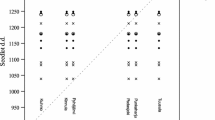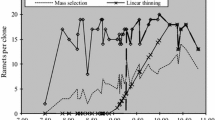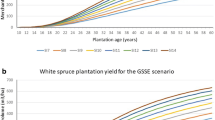Abstract
Tree improvement for important species is over 30 years old in the province of New Brunswick, Canada, and enough data have been accumulated to perform an economic analysis. In this study, we conducted a benefit–cost analysis of an ongoing, first generation, 6.5 ha white spruce clonal seed orchard, established in 1985–1987 in Lower Queensbury, New Brunswick. This seed orchard has provided seed for reforestation on Crown lands in the province since 1993. The analysis was undertaken by evaluating the present values of relative costs, benefits, and benefit/cost ratios (BCRs) associated with a plantation management strategy that uses the Lower Queensbury clonal seed orchard (LQ_CSO) versus one that uses wild stand (unselected) seeds. Cash flows were based on actual costs for the LQ_CSO (including orchard establishment and management, progeny test establishment and maintenance, and data analysis), and projected revenue increases from the genetic gains associated with the LQ_CSO relative to the unselected seedlot. Genetic gains at rotation ages were predicted using a growth and yield model that used 20-year old data collected from a realized gain test, and considered two rotation ages (40 and 50 years) along with two management scenarios (with vs. without commercial thinning). A number of discount rates (from 4 to 8 %) were also assessed. Findings indicated that the BCRs ranged from 12.5 to 0.4, depending on the scenario considered, with a majority being >1. BCRs increased when commercial thinning was applied, but declined marginally when the rotation age was extended from 40 to 50 years. Overall, the results demonstrated that the establishment of the LQ_CSO was an excellent investment for all scenarios when the discount rate was <6 %.




Similar content being viewed by others
References
Carlisle A, Teich AH (1971) The costs and benefits of tree improvement programs. Dept. of the Environ., Can. For. Serv. Pub. 1302, 34 p, Ottawa
Cornelius JP (1984) An economic analysis of black spruce (Picea mariana [Mill.] B.S.P.) breeding in New Brunswick. M.Sc. thesis, University of New Brunswick, Fredericton
Davis LS (1967) Investments in loblolly pine clonal seed orchards. J For 65:882–887
Fins L, Moore JA (1984) Economic analysis of a tree improvement program for western larch. J For 82:675–679
Ford D, Merrill RE, Mohn CA, Stine RA (1983) Economic analysis in planning the Minnesota Department of Natural Resources tree improvement program. In: Proceedings of the third north central tree improvement conference. Department of Forestry, University of Wisconsin, Madison, pp 128–136
Fowler DP, Park YS (1983) Population studies of white spruce. I. Effects of self-pollination. Can J For Res 13:1133–1138
Kula E (1984) Derivation of social time preference rates for the Unites States and Canada. Q J Econ 85:873–882
Ledig FT, Porterfield RL (1981) West coast tree improvement programs: a break-even, cost–benefit analysis. Pacific Southwest Forest and Range Experiment Station, Res. Paper PSW-156, 8 p. Pacific Southwest Forest and Range Exp. Stn., Forest Serv., U.S. Dep. Agric., Berkeley, CA
McKenney DW, van Vuuren W, Fox GC (1989) An economic comparison of alternative tree improvement strategies: a simulation approach. Can J Agric Econ 37:211–232
New Brunswick Tree Improvement Council (NBTIC) (1985) Establishment of the white spruce clonal seed orchard. Establishment Report No.20. Fredericton, New Brunswick
NBTIC (1989) 1989 white spruce progeny tests. Establishment Report No. 30. Fredericton, New Brunswick
NBTIC (1990) 1990 white spruce progeny tests. Establishment Report No. 32. Fredericton, New Brunswick
NBTIC (1993) 1993 white spruce realized gain test. Establishment Report No. 41. Fredericton, New Brunswick
Park YS, Weng YH, Mansfield SD (2012) Genetic effects on wood traits of plantation-grown white spruce (Picea glauca) and their relationships with growth traits. Tree Genet Genomes 8:303–311
Porterfield RL, Ledig FT (1977) The economics of tree improvement programs in the Northeast. In: Proceedings of twenty-fifth northeast forest tree improvement conference, July 27–29, 1977. Orono, Maine, pp 35–47
Porterfield RL, Zobel BJ, Ledig FT (1975) Evaluating the efficiency of tree improvement programs. Silvae Genet 24:22–44
Price C (1989) The theory and application of forest economics. Basil Blackwell Ltd., Oxford
Row C, Kaiser HF, Sessions J (1981) Discount rate for long-term forest service investment. J For 79:367–369
Stier JC (1990) Economic efficiency of forest tree improvement programs in the north central region. Eval Rev 14:227–246
Thomson TA, Lester DT, Martin JA, Foster GS (1989) Using economic and decision making concepts to evaluate and design a corporate tree improvement program. Silvae Genet 38:21–28
van Buijtenen JP, Saitta WW (1972) Linear programming applied to the economic analysis of tree improvement. J For 70:164–167
Weng YH, Kershaw J, Tosh KJ, Adams G, Fullarton MS (2008) Height–diameter relationships for jack pine seedlots of different genetic improvement levels. Silvae Genet 57:276–282
Weng YH, Park YS, Simpson D, Tosh KJ, Fullarton MS (2010) Tree improvement effects on tree size distributions for white spruce and black spruce in New Brunswick, Canada. Scand J For Res 25:10–20
Weng YH, Tosh KJ, Fullarton MS (2011) Determining and projecting realised genetic gains: results from early-stage spruce improvement programmes in New Brunswick, Canada. NZ J For Sci 40:5–17
White TL, Adams WT, Neale DB (2007) Forest genetics. CABI Publishing, Cambridge, p 682
Zobel BJ, Talbert JT (1984) Applied forest tree improvement. Wiley, New York
Acknowledgments
We appreciate the dedicated NBTIC members who contributed so much to the success of this program. Thanks also go to Ms. Kathy Tosh, Mr. Chris Ward and Mr. Martin Noël, Forest Management Branch, NB Department of Natural Resources, for their kindly help in providing relevant data.
Author information
Authors and Affiliations
Corresponding author
Rights and permissions
About this article
Cite this article
Wu, Y.Q., Weng, Y.H., Hennigar, C. et al. Benefit–cost analysis of a white spruce clonal seed orchard in New Brunswick, Canada. New Forests 46, 141–156 (2015). https://doi.org/10.1007/s11056-014-9453-5
Received:
Accepted:
Published:
Issue Date:
DOI: https://doi.org/10.1007/s11056-014-9453-5




